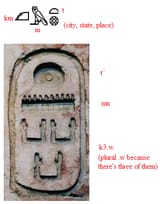Search Results
7/12/2025, 12:31:09 AM
>>17833579
Egyptian hieroglyphics had no punctuation. Nouns were usually easily separated in a reader's mind because of extensive repetition and use of determinatives at the end of words to show what class it belonged to.
For example, the Egyptian name for Egypt, km.t = "Black Land" so named after its fertile black soil [Gardiner number in brackets]:
[I6] "km", biliteral sign used as phonogram
[G17] "m", uniliteral sign to show that the previous hieroglyph had a pronunciation that ended with the consonant m (as some had multiple possible pronunciations)
[X1] "t", the feminine suffix (transcribed as .t) as was common for lands
[O49] determinative symbol, to show that the whole word was a place-name
Triliteral signs would often in a similar fashion be followed by a biliteral sign and a third uniliteral sign, plus suffixes and determinatives, in an overly cautious method to ensure a priest was able to read the writing on the wall correctly.
Royal names having cartouches around them might be counted as a rare type of punctuation, but those often had other confusing fuckery, like putting a god's name in the beginning as a sign of honor when it was pronounced last.
The bottom shows pharaoh Menkaura's name in a cartouche, which one might naively read from top to bottom as something like Ramenkau. (Note that the vowels are imaginary and follow the conventional Egyptological method of making strings of consonant-only text pronounceable to another archeologist while doing fieldwork)
Egyptian hieroglyphics had no punctuation. Nouns were usually easily separated in a reader's mind because of extensive repetition and use of determinatives at the end of words to show what class it belonged to.
For example, the Egyptian name for Egypt, km.t = "Black Land" so named after its fertile black soil [Gardiner number in brackets]:
[I6] "km", biliteral sign used as phonogram
[G17] "m", uniliteral sign to show that the previous hieroglyph had a pronunciation that ended with the consonant m (as some had multiple possible pronunciations)
[X1] "t", the feminine suffix (transcribed as .t) as was common for lands
[O49] determinative symbol, to show that the whole word was a place-name
Triliteral signs would often in a similar fashion be followed by a biliteral sign and a third uniliteral sign, plus suffixes and determinatives, in an overly cautious method to ensure a priest was able to read the writing on the wall correctly.
Royal names having cartouches around them might be counted as a rare type of punctuation, but those often had other confusing fuckery, like putting a god's name in the beginning as a sign of honor when it was pronounced last.
The bottom shows pharaoh Menkaura's name in a cartouche, which one might naively read from top to bottom as something like Ramenkau. (Note that the vowels are imaginary and follow the conventional Egyptological method of making strings of consonant-only text pronounceable to another archeologist while doing fieldwork)
Page 1
